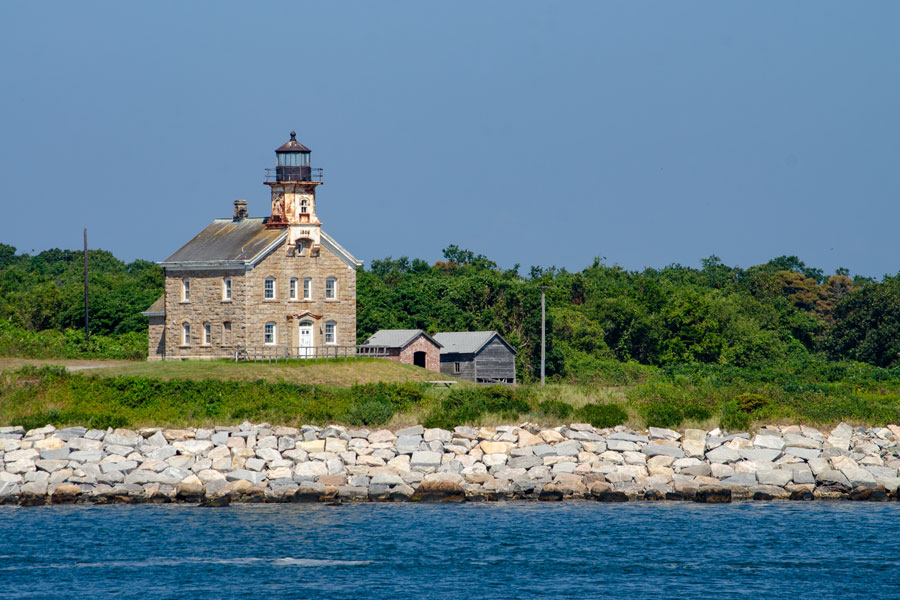Plum Island, New York

Plum Island is an 840-acre island situated in Long Island Sound, just two miles off Orient Point on the North Fork of Long Island. Though technically part of Suffolk County, the island has been under federal control for more than a century and remains closed to the public. Best known as the home of the Plum Island Animal Disease Center (PIADC) since 1954, the island is also rich in history and ecology, making its future a subject of ongoing debate.
Geography & Location
- Coordinates: Just east of Orient Point, Suffolk County, NY
- Size: 840 acres
- Nearby Landmarks: Gardiners Island, Fishers Island, Montauk Point
- Access: Restricted; federal ferries operate from Old Saybrook, CT, and Orient Point, NY
The island contains a mix of sandy shoreline, rocky outcrops, salt marshes, meadows, and forest, providing critical habitat for wildlife along the Atlantic Flyway.
History
- Early Federal Use: The U.S. government purchased Plum Island in 1899.
- Fort Terry (1901–1950s): Built as part of America’s coastal defense network, the fort later served in World Wars I and II.
- Submarine Base: During World War II, the island briefly supported Navy submarine operations.
- Animal Disease Center: In 1954, the U.S. Department of Agriculture opened the PIADC to research highly contagious livestock diseases. The facility transitioned to the Department of Homeland Security in 2024.
- Future Transition: Research operations are moving to the new National Bio and Agro-Defense Facility (NBAF) in Kansas, expected to be fully operational by 2026.
Ecology & Wildlife
Plum Island is ecologically diverse and recognized as a significant conservation site. Habitats include:
- Tidal flats and salt marshes
- Sand dunes and barrier beaches
- Meadows and maritime forests
Notable wildlife:
- Harbor and gray seals frequently haul out on its shores
- Migratory birds using the island as a stopover along the Atlantic Flyway
- Endangered species including roseate terns and piping plovers
Because of these natural features, environmental advocates have lobbied for the island to become a protected preserve once the laboratory is decommissioned.
Structures on the Island
While no private homes exist on Plum Island, several types of buildings remain:
- Military remnants: Fort Terry’s gun batteries, barracks, and support structures still stand in varying states of preservation.
- Research facilities: The PIADC laboratory complex dominates the island, surrounded by biosecurity fencing and specialized containment buildings.
- Housing and cottages: Small government-owned residences were built for staff who needed to remain on-site. These include modest cottages, dormitories, and utility buildings that sometimes resemble homes in photographs.
- Harbor and utilities: The island has a ferry dock, warehouses, power generation facilities, and maintenance sheds to support its self-contained operations.
Many of these structures are now disused or in partial decay, adding to the island’s mysterious reputation.
Historic Lighthouse
On the western tip of Plum Island stands Plum Island Light, a stone lighthouse built in 1869 to guide vessels through the busy waters of Long Island Sound. The two-story granite structure, with its attached keeper’s quarters, was vital for navigation in the era before modern electronic aids.
Although the lighthouse was deactivated in 1978, it remains a significant historic landmark. In 2011, Plum Island Light was officially added to the National Register of Historic Places, recognizing its importance to maritime history. Today, the lighthouse is closed to the public, but it still stands as one of the island’s most visible and enduring structures, symbolizing Plum Island’s role in the region’s nautical past.
Future of Plum Island
The island’s future remains undecided. A 2008 law required it to be sold to private developers, but in 2020 Congress reversed the decision, barring commercial development. Today, Suffolk County has been invited to assume stewardship once federal operations end, potentially in partnership with conservation groups.
Preservation advocates envision the island as a wildlife refuge and historical site, balancing ecological protection with limited public access. Cleanup, contamination concerns, and the costs of long-term management remain central issues in these discussions.
Controversies & Conspiracy Theories
Plum Island’s secrecy has long made it a focus of speculation:
- Lyme Disease Theory (Fiction): Some claim Lyme disease originated at the lab. Scientific research shows Lyme disease existed in North America long before the PIADC was established.
- Montauk Monster (Unexplained): A mysterious carcass washed up in Montauk in 2008, sparking rumors it came from Plum Island. Experts say it was likely a decomposed raccoon, though no examination was performed before the body vanished.
- Biological Weapons Rumors (Fiction): During the Cold War, secrecy fueled theories of weapons testing, but no evidence supports the claim.
- Ongoing Incidents (Fact): Accidents have occurred at the facility, including staff exposures and safety alerts, most recently in 2025 when seven employees were briefly hospitalized after a sterilization process caused eye irritation.
Public Access
Plum Island remains closed to the general public. Access is restricted to federal employees, researchers, and authorized personnel. If future stewardship transfers to local control, proposals include:
- Guided tours for ecology and history
- Wildlife refuge status for birding and seal-watching
- Historic interpretation of Fort Terry’s remains
Quick Snapshot
| Feature | Details |
|---|---|
| Location | Long Island Sound, Suffolk County, NY |
| Size | 840 acres |
| Status | Federal property, closed to public |
| Facility | Plum Island Animal Disease Center (since 1954) |
| Future | Research relocating to Kansas by 2026; county stewardship debated |
| Ecology | Marshes, dunes, meadows; seals, migratory birds, rare species |
| Structures | Fort Terry remnants, lab complex, staff housing, harbor |
Did You Know?
- Plum Island once housed Fort Terry, a U.S. Army coastal defense installation.
- The island is only reachable by federal ferries from Connecticut and Long Island.
- Each winter, hundreds of harbor seals gather along its shores.
- Its long-closed status has fueled myths and conspiracy theories that remain part of Long Island lore.

